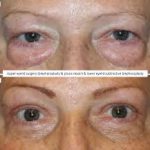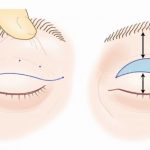Blepharoplasty is the plastic surgery operation for correcting defects, deformities, and disfigurations of the eyelids; and for aesthetically modifying the eye region of the face.
With the excision and the removal, or the repositioning (or both) of excess tissues, such as skin and adipocyte fat, and the reinforcement of the corresponding muscle and tendon tissues, the blepharoplasty procedure resolves functional and cosmetic problems of the periorbita, which is the area from the eyebrow to the upper portion of the cheek.
What eyelid surgery can treat
- Loose or sagging skin that creates folds or disturbs the natural contour of the upper eyelid, sometimes impairing vision
- Fatty deposits that appear as puffiness in the eyelids
- Bags under the eyes
- Drooping lower eyelids that reveal white below the iris
- Excess skin and fine wrinkles of the lower eyelid
Who is a good candidate for eyelid surgery?
Good candidates for eyelid surgery include:
- Healthy individuals with no medical conditions that can impair healing
- Nonsmokers
- Individuals with a positive outlook and realistic goals
- Individuals without serious eye conditions
Remember that the eyelids are part of the face. The appearance of a drooping upper lid may also be due to relaxation of the forehead skin and eyebrow. Sometimes stretching out of the upper eyelid muscle may cause a drooping eyelid. This is called eyelid ptosis and requires a different surgical treatment.
Your plastic surgeon will evaluate your facial anatomy thoroughly and will discuss what procedures might best remedy your concerns.
What age can you get blepharoplasty?
Most people who get eyelid surgery are in their 30s or older. But no real age requirement exists for blepharoplasty — it can be safely performed on younger patients. That said, cosmetic surgeons generally recommend waiting until at least age 18.
Is eyelid surgery dangerous?
As with any surgery, there are potential risks and complications of blepharoplasty. The major risks include infection, bleeding, scarring, inability to close the eyes, dry eye, abnormal eyelid position, double vision, and loss of vision.
Does blepharoplasty make you look younger?
The cosmetic reason people choose eyelid surgery is that it makes you look younger and improves your appearance — sometimes dramatically. If you look at before-and-after photos of patients, you can see how surgery on both upper and lower eyelids makes a profound difference in the appearance of the skin around the eyes.
Can I sleep on my side after eyelid surgery?
Answer: After eyelid surgery, for the first few days it is ideal to sleep on your back, with your head elevated in order to decrease swelling, however, if you accidentally turn over during the night, and lie on your side, you are very unlikely to have any negative side effects from this.
https://en.wikipedia.org/wiki/Blepharoplasty
https://www.plasticsurgery.org/cosmetic-procedures/eyelid-surgery
http://www.mobleymd.com/what-age-is-best-for-an-eyelid-lif
https://www.medicinenet.com/blepharoplasty__eyelid_surgery/article.htm
https://www.levineplasticsurgery.com/blog/how-eyelid-surgery-will-make-you-look-younger
https://www.williamsfacialsurgery.com/blog/will-i-be-able-sleep-my-side-after-my-eyelid-surgery





